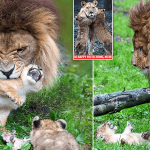
Michael McCarthy was canoeing via the Intracoastal Waterway close to St. Petersburg, Florida, when he noticed the acquainted flash of silver within the water forward of him. A dolphin was swimming close by, and she or he seemed to be cradling a small, limp physique.

At first, McCarthy thought the dolphin had simply caught her dinner, however as he watched, a heartbreaking scene unfurled earlier than him.

“It took me a minute to simply accept what I used to be seeing after I first noticed the dolphin,” McCarthy, the proprietor of the See By means of Canoe Firm, instructed The Dodo. “I needed to consider it was a big redfish or one thing, however it rapidly grew to become obvious that it was a useless calf.”
McCarthy whipped out his digital camera and commenced filming the mom dolphin’s funeral procession. She nuzzled the physique of her calf, caressing it in a dance of grief.
Fortunately, she wasn’t alone. A fellow dolphin swam alongside her, in a seeming effort to guard and luxury his pal. “Because the mom made her approach north via the Intracoastal Waterway, different dolphins joined her for brief distances after which went on their approach,” McCarthy stated, “apart from one dolphin that stayed with the mom the entire time.”

The calf seemed to be the sufferer of a run-in with a motorboat — one thing McCarthy has witnessed all too ceaselessly. “Judging by the scar patterns on the calf it was probably hit by a ship propeller,” McCarthy stated. “I’ve spent most of my life on the water and plenty of time round manatees and dolphins so, sadly, I’m very aware of what propeller wounds appear to be.”
This made McCarthy much more decided to seize the dolphin’s grief on movie, in an effort to “assist increase consciousness to an issue I see on a regular basis,” he famous.
A standard false impression amongst boaters is that dolphins are “too quick to get hit,” notes McCarthy, however that’s simply not true. “The calves are much more weak as a result of they will’t swim as quick and need to floor far more ceaselessly for air,” he added.
Earlier research recommend that cetaceans — dolphins and whales — show grieving behaviors, particularly moms mourning their useless calves.
McCarthy posted the video to Twitter final week, and it has since been seen over 76,000 instances.

“It was actually onerous to observe,” McCarthy wrote on Twitter. “That picture goes to be caught in my head for some time.”
What 5 traits do all animals have in frequent?
What 5 traits do all animals have in frequent?
Within the following slides, we’ll discover the essential traits shared by all (or at the least most) animals, from snails and zebras to mongooses and sea anemones: multicellularity, eukaryotic cell construction, specialised tissues, sexual replica, a blastula stage of improvement, motility, heterotrophy and possession …
What traits do all animals have in frequent quizlet?
The six traits that each one organisms within the animal kingdom share are: they’re multicellular, nearly all can transfer, their cells don’t have any cell wall, they need to hunt for their very own meals (shoppers), they’re eukaryotic, reproduce sexually-when two cells be a part of to type off spring and their cells lack chloroplasts.
What 4 traits do all animals share?
Most animals share these traits: sensory organs, motion, and inner digestion. All of them are illustrated in Determine beneath. Animals can detect environmental stimuli, corresponding to mild, sound, and contact. Stimuli are detected by sensory nerve cells.
What are the 7 traits of all animals?
- 1 Diet. Dwelling issues absorb supplies from their environment that they use for progress or to supply vitality.
- 2 Respiration.
- 3 Motion.
- 4 Excretion.
- 5 Progress.
- 6 Replica.
- 7 Sensitivity.
What are the 6 traits frequent to all animals?
They’re as follows:
- All animals are made up of cells that do not need cell partitions.
- All animals are multicellular organisms.
- Most animals reproduce sexually.
- All animals are able to self-propelled movement in some unspecified time in the future of their lives.
- All animals are heterotrophic and should eat different organisms for vitality.
What protein do all animals have in frequent?
The exctracellular protein collagen (making probably the most considerable extracellular protein in animals) which is required in multicellular organisms to maintain the cells collectively, which is unique to animals. Most enzymes accountable for metabolic pathways.
What are the three traits of animals?
Traits of Animals
- Animals are multicellular organisms.
- Animals are eukaryotic.
- Animals are heterotrophic.
- Animals are typically motile.
- Animals possess specialised sensory organs corresponding to eyes, ears, nostril, pores and skin, and tongue.
- Animals reproduce sexually.
What are the essential traits of all animals?
Within the following slides, we’ll discover the essential traits shared by all (or at the least most) animals, from snails and zebras to mongooses and sea anemones: multicellularity, eukaryotic cell construction, specialised tissues, sexual replica, a blastula stage of improvement, motility, heterotrophy and possession of a sophisticated nervous system.
What do all animals have in frequent with one another?
Sexual replica is one other attribute shared by most, however not all, animals. No matter species, all animals share multicellularity, which suggests their our bodies encompass a number of cells. This units animals other than organisms, corresponding to single-celled algae, fungi, micro organism and different fundamental life kinds.
What do crops and animals have in frequent?
Most crops are additionally multicellular, so though this can be a attribute shared by all animals, it isn’t one distinctive to animals.Each animal on the planet is a eukaryote. A eukaryote is an organism that consists of cells which have membrane-bound nuclei and organelles.
What are the traits of the animal kingdom?
All animals are eukaryotic, multicellular organisms, and most animals have advanced tissue construction with differentiated and specialised tissue. Animals are heterotrophs; they need to eat residing or useless organisms since they can not synthesize their very own meals and could be carnivores, herbivores, omnivores, or parasites.



